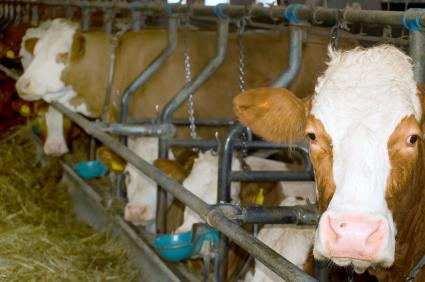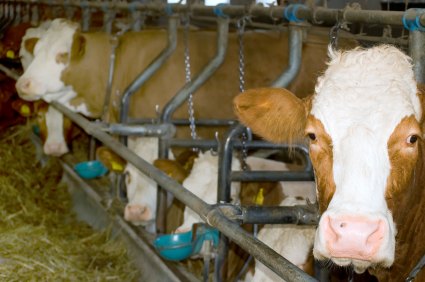 What the hell are you feeding us?In Meat Wagon, we round up the latest outrages from the meat and livestock industries.
What the hell are you feeding us?In Meat Wagon, we round up the latest outrages from the meat and livestock industries.
————-
Agricultural societies, I imagine, have always fed waste products to livestock. On diversified farms, pigs and chickens get lots of kitchen scraps and “culls”–produce that can’t be sold. And it’s worthwhile to keep cows around if you have access to pasture–cows convert a wild, low-input perennial crop (grass), which humans can’t digest, into highly nutritious beef and milk.
But as agriculture industrialized, the waste products that farmers serve to farm animals have industrialized, too. Before the rise of massive facilities that house thousands of chickens and vast feedlots that confine thousands of cows, I doubt anyone thought of feeding “chicken litter”–feces mixed with bedding, feathers, and uneaten feed–to cows. Chicken litter was a valuable fertilizer; it added not just nitrogen and other nutrients to soil, but also plenty of organic matter.
But with the rise of industrial chicken production, farms produced way too much litter to be absorbed by nearby land (not that they don’t often severely overload the land around them).
So what was once a resource has become a waste problem–and one solution has been to feed chicken litter to cows. Cows consume between 1 million and 2 million tons of chicken waste per year–and then we consume those cows This is a vile practice that should be banned. Here’s how Consumers Union describes the quality of chicken litter as cow feed:
Poultry litter consists primarily of manure, feathers, spilled feed and bedding material that accumulate on the floors of the buildings that house chickens and turkeys. It can contain disease-causing bacteria, antibiotics, toxic heavy metals, restricted feed ingredients including meat and bone meal from dead cattle, and even foreign objects such as dead rodents, rocks, nails and glass. Few of these hazards are eliminated by any processing that might occur before use as feed. The resulting health threats include the spread of mad cow disease and related human neurological diseases, the development of antibiotic resistant bacteria, and the potential for exposure to toxic metals, drug residues, and disease-causing bacteria.
That description reminds us that the regulation of livestock feed is pretty minimal.
As I’ve reported before, feedlot operators are feeding cows more and more distillers grains–waste from the corn-ethanol process–even though regulators acknowledge that the practice seems to encourage the growth of the deadly-to-humans pathogen E coli 0157. Distillers grains are also loaded with antibiotic residues and various industrial chemicals.
Given that food-safety authorities are only too willing to let filthy industrial waste be fed to the animals that we eventually eat–and overlook clear evidence of health consequences in the process–no one should be surprised that the biodiesel industry is jonesing for a piece of the livestock-feed market. The main industrial waste product from biodiesel is glycerin, a substance often used in cosmetics. As biodiesel production ramps up, the industry is churning out much more of the stuff than it can sell to the cosmetic industry.
And even when biodiesel producers can sell their glycerin for that purpose, the stuff first must be purified–an energy-intensive and expensive process. Often, biodiesel plants spend more purifying glycerin than they get back in sales. So there’s a huge glut, and the industry is looking for a place to profitably dump a bunch of unpurified glycerin. Can anyone guess not what comes next?
Get this, from Farm & Ranch Guide:
Crude glycerin can be purified for use in human products such as cosmetics, pharmaceuticals, and a variety of food items. Purification of crude glycerin is a costly and energy-intensive procedure; therefore, glycerin intended for livestock consumption is normally not purified.
Yes, glycerin is now flowing from biodiesel factories to feedlots, without being purified in between.
I have no idea if cows fed on industrial glycerin suffer ill health effects. Nor, I’d wager, do food-safety authorities. But if evidence of such effects arises, we have no reason to think that authorities will intervene to stop the practice.
Enough tainted burger to infect the whole Mexico City
Last time the ol’ Meat Wagon got cranked up, California-based Huntington Meat Pack had recalled 860,000 pounds of ground beef laced with e. coli 0157. That was enough tainted product, we calculated at the time, to make the equivalent of 3.56 million Quarter Pounders. Whoa.
But it turns out that. like a certain car maker, Huntington didn’t cast its recall net quite wide enough. From a USDA press release:
Huntington Meat Packing Inc., a Montebello, Calif., establishment, is expanding its recall of January 18 to include approximately 4.9 million additional pounds of beef and veal products that were not produced in accordance with the company’s food safety plan. The products are adulterated because the company made the products under insanitary conditions failing to take the steps it had determined were necessary to produce safe products, the U.S. Department of Agriculture’s Food Safety and Inspection Service (FSIS) announced today.
Damn: an additional 4.9 million pounds, produced “under insanitary conditions.” According to our proprietary mathematical models, that’s enough dodgy beef to make 19.6 million Quarter Pounders. The two recalls combine for a grand total of 24.5 million Quarter Pounders, or enough to (potentially) sicken every man, woman, and child in Mexico City–with a few million burgers left over for suburbanites. (Attention meat industry: this is not an invitation to dump recalled meat on foreign markets!)
The scale is colossal, jaw-dropping; the big numbers had Meat Wagon’s trusty IBM mainframe sending out smoke signals.
And it gets worse; there could literally be foul play involved. Back to the press release:
The recall was expanded based on evidence collected in an ongoing criminal investigation being conducted by the Office of the Inspector General (OIG) with assistance from FSIS. This evidence shows that the products subject to this recall expansion were produced in a manner that did not follow the establishment’s Hazard Analysis and Critical Control Points (HACCP) plan. A HACCP plan describes the process controls an establishment must take to prevent food safety hazards and create a safe and wholesome product. The investigation has uncovered evidence to show that the food safety records of the establishment cannot be relied upon to document compliance with the requirements. Therefore, FSIS must consider the products to be adulterated and has acted to remove the products from commerce.
I hope this means that the USDA’s Food Safety and Inspection Service (FSIS), which oversees the meat industry on safety issues, is finally growing a set of …uh, teeth. Not long ago, the Obama administration finally named and FSIS director, after dawdling for a year. Last week, the agency ramped up its amazingly lax standards around the safety of meat served in schools. As Tom Laskawy out it, let’s hope these are “the seeds, and not the crumbs, of change.”
Here’s a litmus test: how about banning the dumping of disgusting industrial waste products in animal feed, like chicken litter and distillers grains?



